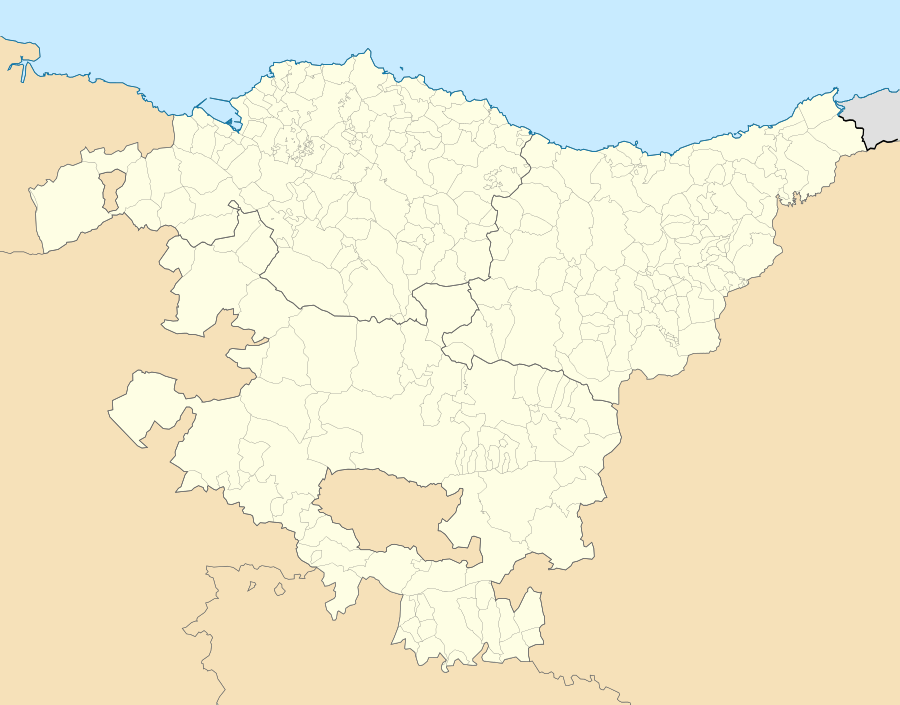Ataria
| Ataria Interpretation Centre | |
|---|---|
| Ataria – Centro de Interpretación de la Naturaleza de Salburúa | |
|
Ataria wetlands interpretation centre | |
 Ataria Ataria, within the Basque Country | |
| Nearest city | Vitoria-Gasteiz |
| Coordinates | 42°50′28.71″N 2°41′56.30″W / 42.8413083°N 2.6989722°WCoordinates: 42°50′28.71″N 2°41′56.30″W / 42.8413083°N 2.6989722°W |
| Created | 2009 |
| Designer | QVE Arquitectos |
| Operated by | Ayuntamiento de Vitoria-Gasteiz |
| Visitors | 100,000 (in July 2009 - June 2010)[1] |
| Open | 10:00-14:00, 16:00-19:00 (winter); 10:00-14:00, 16:00-20:00 (summer) |
| Website | Official website |
Ataria Interpretation Centre is a wetlands interpretation centre and natural history museum for the Salburua wetlands, a Ramsar site and a significant wetlands habitat in the Basque Autonomous Community. The wetlands region is an important green belt on the eastern outskirts of the city of Vitoria - Gasteiz in Álava-Araba province.[2] Ataria showcases the value of the wetlands, which are classified as a class 1 Habitat of European Community Interest, and the importance of biodiversity to Vitoria-Gasteiz's natural heritage.[2] The Salburua marshes are considered to be "the Basque country's most valuable area of wetland", according to a Fedenatur report for the European Commission in 2004.[3]
Features
The centre complex was officially opened in July 2009, after three years of construction, at a cost of just under €7 million.
Building
The contemporary building was designed by QVE Arquitectos of Madrid, Spain.[4] It was shortlisted for the World Architecture Festival in 2008[5] and nominated for the "Mies Arch Award" in 2009.[6] Its construction is considered unique in that the building extends over the wetlands it examines.[7] 100,000 visits to the centre were recorded in the first year of operation.[1]
The building houses an auditorium, interactive exhibits, classrooms and laboratories for educational use, a café, and offices for the Vitoria-Gasteiz Centre for Environmental Studies.[5][8]
Observation deck
A cantilevered observation deck, 19.2 metres (63 ft) long, allows visitors to look out over the marshlands. The enclosed walkway deck was constructed of laminated veneer lumber and steel bar trusses. Concrete and steel anchors transfer the force to the ground. The structure was described as "singular" in a paper by Professor J. L. Fernández-Cabo, who compared it to the large cantilevered timber roof of a pavilion at Hanover fairgrounds.[9]

References
- ↑ 1.0 1.1 Staff (19 May 2010). "Ataria cierra su primer año de vida con cerca de 100.000 visitas". Diario de Noticias (in Spanish). Retrieved 23 April 2012.
- ↑ 2.0 2.1 "Natura 2000 Site Management Case-study: Salburua Wetland, ES". natura.org. 2009. Retrieved 22 April 2012.
- ↑ "The Place of Periurban Natural Spaces for a Sustainable City" (PDF). European Commission. January 2004. p. 6. Retrieved 23 April 2012.
- ↑ "Ataria Vitoria, Building Spain, Centro de Interpretación de la Naturaleza de Salburúa". e-architect.co.uk. 1 September 2008. Retrieved 23 April 2012.
- ↑ 5.0 5.1 "ATARIA - Centro de Interpretación de la Naturaleza de Salburúa". World Buildings Directory. Retrieved 21 April 2012.
- ↑ "ATARIA - Nature Interpretation Centre of Salburúa". Mies Arch. Retrieved 21 April 2012.
- ↑ Beatley, Timothy (2010). Biophilic Cities: Integrating Nature Into Urban Design and Planning. Island Press. p. 76.
- ↑ Salathé, Tobias (16 September 2009). "Urban wetlands – how to implement Resolution X.27". ramsar.org. Retrieved 23 April 2012.
- ↑ Fernández-Cabo, José L. (1 November 2009). "A timber cantilevered view walkway in Vitoria, Spain" (PDF). Proceedings of the ICE - Construction Materials 162 (4): 167–174. doi:10.1680/coma.2009.162.4.167. Retrieved 23 April 2012.
External links
| Wikimedia Commons has media related to Ataria Interpretation Centre of the Salburua wetlands. |
